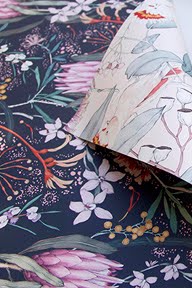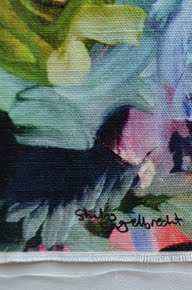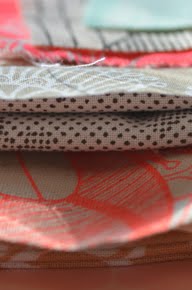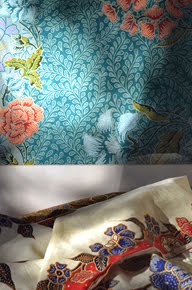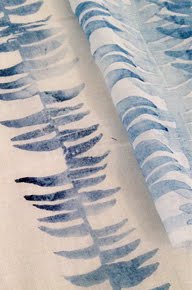 |
| Batik sarongs, purchased in Bangkok and Nepal, and carried around the world. Photo: Threadbound |
It was during these days that an urgent idea tugged Carry Somers from the sanctuary of her London bath. A fair fashion pioneer, 23 years at the helm of Pachacuti, a fair trade hat company she created, had given her the insight to act. She phoned friend Orsola De Castro to describe the beginning bones of Fashion Revolution Day. Quickly supported by the Observer’s Ethical Living columnist, Lucy Siegle, the three were unanimous in their belief that the seeds of this social media campaign were significant enough to ignite real change in the fast fashion industry.
Held each year on 24 April, the anniversary of the collapse, the campaign has asked followers to find out where their clothing comes from to. They believe an increased consumer call for transparency in the fashion train will ultimately change people's buying behaviour and create “an industry which values people, the environment, creativity and profits in equal measure”. The campaign has thrown down the gauntlet to each link in the chain with a series of simple steps to get the world thinking, talking and ultimately acting in ways that are better for all us. This year, with a suspected reach of over 124 million people in 71 countries and tens of thousands of people seen to be actively questioning who made their clothes, this idea from the soapy depths has traction, as well as a whole lot to say about where many of our products come from.
 |
| Time softened sarongs. Photo: Threadbound |
Often described as the fashion industry’s ‘call to arms’, the seeds of Somers’ initial idea were sewn right back at the start of her own entrepreneurial journey. Witnessing the injustice faced by two groups of Ecuadorian hand knitters, the Pachacuti About page explains that she “took inspiration from Anita Roddick's autobiography, and decided that if one woman could have such a positive impact on the beauty industry, there was nothing to stop her from trying to do the same within the fashion industry.”
If Somers could apply Roddick’s beauty learnings to fashion, could textile owners and makers not also look to our sister industry to learn about what we are doing? As the shadows start to stretch on the second successful Fashion Revolution Day, it would seem that many of the ways to curb our 80 billion articles of clothing per year habit could be powerfully applied to the way we make and choose the textiles for our homes.
As with fashion, there are already so many makers, buyers and designers who are living proof of the simple things we can consider when we make and purchase our textiles. From consuming less to buying better, so many of the things we can each do to change our current break neck patterns hark back to simple values practiced in our not so distant past. These timeless truths call for the return of craftspeople and their skills. And the beauty of these salves is that everyone is better off – from those faceless workers, to the environment, to the buyers who each have the capacity to carefully collect and curate a home of beautiful things.
 |
| A sarong stack full of memories. Photo: Threadbound |
Somers suggests in the Fashion Revolution blog that “designers can meet human needs by offering fashion with emotional significance. By telling the story behind a garment or inviting the customer to be part of the design process, our need for creativity, identity and participation can be satisfied. Consumer demand can revolutionise the way fashion works as an industry. If everyone started to understand that they can be part of the solution, we’d see a radically different fashion paradigm.”
Her event co-founder, Orsola De Castro, also suggests that meaning is the ticket in a post by Bruno Pieters, saying “Our ancestors would have known the precise history and origin of the few things they owned as well as the people and tools involved in making them. And today in some crucibles of commercial exchange like the farmer’s market; human relationships, eye contact and knowledgeable conversation is thriving. Across a table of vegetables or stall of baked goods there is connection between buyer and seller forged over skilled production, geography, provenance and ingredients. But such trusted human connections get severed when things are scaled up: it’s impossible to sustain relationships across a colossal, globally spread, multi-part supply chain. So in lieu of direct human connection, we have generated data.”
“Over the years I have seen more and more of our local, European manufacturers being abandoned for countless, faceless concerns in China, or Vietnam, or wherever it’s cheapest. We practically killed our home industry, it’s skills, it’s tradition, it’s culture… and, we have ended up industrialising the globe without keeping alive local artisanal skills, which is criminal almost. I think this too will change, eventually. In the UK, there has been increased attention to local manufacturing, and large companies are increasingly coming back producing to London and Leicester. There has been government and private money given to help re-establish a manufacturing industry, and work is being done to inspire a new generation of students to embrace becoming technicians and pattern cutters rather than all studying fashion design,” she continued.
 |
| Living in a frame for a little while. Photo: Threadbound |
And not suprisingly, much of this familiar wisdom also comes down to cultivating good taste. On Fashion Revolution Day, bloggers and writers everywhere called for people to scale down their consumption and waste. Buying less means choosing well. It means choosing what you love, regardless of fashion. It means cultivating our own unique tastes and using and loving what we have.
Australia has a thriving community of textile enthusiasts, makers and artisans using an incredible array of skill, creativity and technique to create quality furnishing cloth, textiles and homewares. Many of them are grounded in this 'less is more' approach to design and the creation of meaningful products, choosing to add to their repertoire as a result of a slow and natural creative process, rather than a fashion push. Many print on natural and organic cloth, which uses a fraction of the required water supplies and is inevitably sourced from fair trade operatives who offer reasonable wages and conditions to workers. The textiles they offer are a win.
 |
| Morning light. Photo: Threadbound |
Fashion Revolution Day is a perfect prompt to reflect on the textiles you have gathered, and those you covet. If we all scale back and choose wisely and well, we really can all afford the most beautiful and textiles already on offer.

